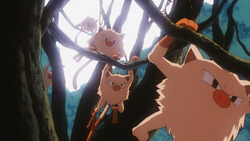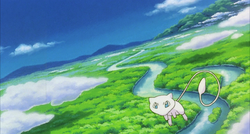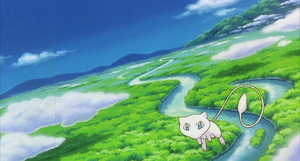User:Salmancer/Guyana revamp

|
This article is intended to be moved into one of Bulbapedia's main content spaces. Be mindful that it is still part of a personal userspace. Any content changes should be brought up on the talk page for this article. |
This article demonstrates how Guyana can be saved, primarily by flipping it around a bit.
Article
South America is a place. It consists of multiple countries[citation needed], of which one is Guyana (Japanese: ギアナ Guiana) South America may or may not be a part of the Pokémon world, but in appearances where it is not, South America and Guyana are places on Earth. Guyana is well known for being the habitat of Mew, a species that is rare and may even be extinct. (Though in practice, Mew usually is not extinct.)
Conceptual History
The earliest Pokémon games were written as though the Kanto region was part of the real world. As such, the backstory of various characters and places included various locations on Earth. Most of these locations have been retconned away by later fiction, either by just not naming a specific place or by swapping it to an analogous location that is explicitly part of the Pokémon world. Guyana, and by extension South America, is a less clear cut case, as you can tell from the intro.
Guyana and South America were first referenced in games Pokémon Red and Pokémon Blue, as part of the Pokémon Mansion journals detailing Mew's backstory. Researchers of the Pokémon Mansion went to Guyana and located Mew. Mew's origins would be put further under the microscope with the release of the film Mewtwo Strikes Back, which included a visual flashback to researchers, this time of Team Rocket, tracking Mew in a jungle. It does not explicitly name South America or Guyana though. However, The Birth of Mewtwo, a radio drama which ties into the film's events, featured both an original expedition to South America and stated the expedition seen in Mewtwo Strikes Back was to South America. (The Birth of Mewtwo's release predates Mewtwo Strikes Back. but The Birth of Mewtwo never released outside of Japan so it is less well known.) To drive the point home further, later releases of Mewtwo Strikes Back in Japan would include an adaption of The Birth of Mewtwo as a prologue. This prologue was not used in the American releases, though later home video releases would include a snippet of it as The Story of Mewtwo's Origin and the full sequence was includied in Mewtwo Returns home video releases as The Uncut Story of Mewtwo's Origin. Pokémon Stadium would conclude the first half decade of Pokémon storytelling by reiterating in a Pokédex entry that Mew originates in South America.
Mew's story would be revisited in Pokémon FireRed and LeafGreen. which continue to feature the Pokémon Mansion journals. The journals were reprinted as-is, and FireRed even adds a Pokédex entry originally taken from the Japanese release of Pokémon Red and Green invoking South America. Things started to change with Pokémon Emerald. All prior instances where Mew could be obtained in a game were event distributions where the Pokémon was added directly to the player's possession. In Emerald, however, an event distribution for the game allowed players to catch a Mew for themselves in the game for the very first time. As such, a properly fictional location was created for Mew to live in before the player finds it: Faraway Island. Faraway Island would go on to make further appearances in Pokémon fiction, including in Pokémon Journeys. While this could be read as retconning Guyana away, there is still one more wrinkle in Guyana and South America's story.
The late 2010's release of Pokémon: Let's Go, Pikachu! and Let's Go, Eevee! reprinted the Pokémon Mansion journals, this time somewhat revised and avoiding naming a specific location at all. This could also be read as a retconning away of Guyana. However, just on the border between the 2010's and the 2020's came the release of Pokémon: Mewtwo Strikes Back—Evolution. A remake of the original Mewtwo Strikes Back, it contains most of the original content of Mewtwo Strikes Back, including the flashback to the original expedition based on The Birth of Mewtwo which still takes place in a still unnamed jungle. However, because it is a remake of Mewtwo Strikes Back, the contents of The Birth of Mewtwo are still applicable to it. Therefore, the film shows a South American jungle.
While Bulbapedia normally follows retcons of this nature and considers the real world locations named but not shown in early Pokémon fiction as mostly non-canonical, this situation does not quite fall into this group. As such, South America is considered to be a Pokémon location.
In the games
Guyana is the location of the jungle where, according to the Pokémon Mansion journalsRBY FRLG, Mew was discovered.
Mew's Pokédex entries from Pokémon Stadium and FireRed mention that it lives in South America.
In Pokémon Emerald, Faraway Island is implied to be the location Mew was found by researchers from the Pokémon Mansion. In the Japanese release, a sign on the island is has a leftover symbol reading ジ (ji). It is possible for this to be a cut off rendition of フジ博士, which is the name for Dr. Fuji in Japanese. Dr. Fuji was the head researcher of Pokémon Mansion. If this is true, this may indicate that the researchers went to Faraway Island and found a Mew. This would then mean that Faraway Island is part of Guyana.
- Main article: South America (Earth)
In Google Maps: Pokémon Challenge, Mew's most common location was in Guyana.
In Pokémon GO, South America is a continent where the game can be played. Various events have taken place in South America, and some aspects of the game are specific to South America.
In the anime
South America is shown, though not named, in various anime depicting Mew and the origins of Mewtwo.
At the beginning of The Uncut Story of Mewtwo's Origin (a short included at the start of the Japanese extended version of Mewtwo Strikes Back), a Team Rocket expedition team led by Dr. Fuji searched a jungle in South America for Mew. The expedition found a fossil of Mew's eyelash, from which they cloned Mewtwo. The first two minutes of this short, set in South America, were added to the beginning of the movie in the international extended version.
In Mewtwo Strikes Back, scenes featuring Mew before it arrives on New Island also appear to be set in South America. Mewtwo's visions of Mew while in Dr. Fuji's cloning lab feature images of the South American jungle.
The film's remake, Mewtwo Strikes Back—Evolution begins with Dr. Fuji leading an expedition in the jungle in South America to find evidence of Mew, whom they believed to be extinct. Meanwhile, Mew observed them from the jungle while frolicking with other Pokémon. From ruins in the jungle that featured a wall carving of Mew, Dr. Fuji's team excavated a fossil from Mew's body—from which they later cloned Mewtwo.
Pokémon seen in South America
 Butterfree |
 Mankey |
 Mew |
In other media
The radio drama The Birth of Mewtwo has two of its five parts involve South America.
In the first part, Miyamoto presented a recording taken from South America by Team Rocket members to Madame Boss. The recording was full of noises from other Pokémon, the enviroment, and of a folk song. However, once all of those distractions were removed, Mew's faint cries could be heard. Apparently, the people in the area recognize Mew as a "phantom Pokémon". Madame Boss sent Miyamoto and two other Team Rocket members to South America to act on this new evidence, but Miyamoto got separated from the others and wound up in a mountain range. Miyamoto endures a blizzard there, which clears up just as Mew appears. Mew escapes, and the blizzard kicks back up. Miyamoto and her team are never referenced again, although Miyamoto may still be alive and continuing to search for Mew.
In the second part, Team Rocket's continual search for Mew results in a success, as a fossil of Mew's eyebrow is found. This fossil is sent to Dr.Fuji's lab on New Island.
Real-world counterpart
(The contents of this section would go on the South America (Earth) article.)
See also
- Pokémon world in relation to the real world
- South America on Wikipedia
- Guyana on Wikipedia

